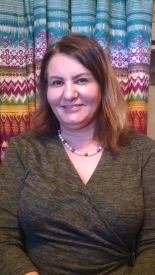By Kendra Sitton for East County Magazine
Photo: Syrian refugee children in El Cajon, by Rachel Williams
April 22, 2020 (San Diego’s East County) -- While it may be true that a virus cannot discriminate, the structural inequalities already in place are exacerbated in a crisis. Groups already in a precarious position are more vulnerable than ever. Among these at-risk groups are immigrants and refugees. According to advocates working with immigrant and refugee communities, some of the top concerns they are hearing involve food insecurity and a lack of resources.
The first wave of panic buying left many immigrants to parse through empty stores on limited budgets after affluent people with access to early information wiped the stock out.
 “By the time information reached the immigrant and refugee community, most of the stores were empty,” explained Elizabeth Lou of the nonprofit organization Nile Sisters (file photo, right). “As people were not prepared, they lacked many things as the quarantine is taking effect.”
“By the time information reached the immigrant and refugee community, most of the stores were empty,” explained Elizabeth Lou of the nonprofit organization Nile Sisters (file photo, right). “As people were not prepared, they lacked many things as the quarantine is taking effect.”
Another major struggle adding to food insecurity has been the closure of schools. Families used to having their children receive two meals per day at school suddenly had to buy enough food to feed everyone each day. While nonprofits have tried to scale up food banks and meal services, the demand is so high that many are struggling to meet it.
 The size of many immigrant families, especially Middle Eastern families, is adding to the strain, according to Dilkhwaz Ahmed (file photo, left) of License to Freedom, an organization based in El Cajon. She told ECM that many households have more than five children to care for in addition to adult extended family members all in the same residence.
The size of many immigrant families, especially Middle Eastern families, is adding to the strain, according to Dilkhwaz Ahmed (file photo, left) of License to Freedom, an organization based in El Cajon. She told ECM that many households have more than five children to care for in addition to adult extended family members all in the same residence.
Ahmed said the limited economic opportunities in El Cajon had families struggling before the crisis even began. Many of the hijabi-wearing women she works with feared discrimination if they sought jobs in other parts of San Diego outside of the East County city that has become an enclave for Middle Eastern immigrants. Language barriers and not being comfortable driving on freeways were other factors that limited their economic opportunities. Many of those who managed to find work have since been laid off during the pandemic.
Language barriers have posed other problems in families receiving resources. Before, people were able to show up to the County offices in person with an advocate or interpreter there to assist them. With caseworkers working remotely, it has been more difficult for many English-language learners to communicate with them by phone and email, according to Ahmed. Resources that could serve them are out of reach for those without regular phone or internet access.
A lack of communication to these vulnerable communities has also meant many are not applying for resources they may qualify for. A member of the City Heights Town Council Board, Chantae Jones, discovered a leader in the Somali Business Association is trying to assist Somali business owners apply for grants and loans. “He's been trying to help people who are English as a second language to fill out these small business grants, because a lot of them don't even know that they exist or they don't know how to find them,” she explained.
Immigrant-owned businesses not part of a business association may have not outside help to fill out the convoluted and long forms.
In addition, many immigrants are barred from receiving federal help like stimulus checks. Millions of tax paying immigrants who are green or white card holders do not qualify for the one-time $1,200 payment. Even American citizens married to an immigrant without a Social Security number will not be able to get their own stimulus checks, MSN reports. While this action as well as President Trump’s recent ban on all immigration point to the federal government’s lack of care at best, and punitive punishment of immigrants at worst, state and local governments are trying to assist vulnerable communities, including undocumented immigrants. However, they have significantly less financial resources to do so.
Governor Gavin Newsom unveiled a plan last week to give $500 to undocumented immigrants.
 “That's gonna help a lot of our undocumented population because they're not eligible for unemployment. They're not eligible for any other resources that require Social Securities or documentation,” said Estela de los Rios of C4SA (file photo, right). She believes this is especially needed because many undocumented workers were subjected to pay lower than minimum wage even while they were working.
“That's gonna help a lot of our undocumented population because they're not eligible for unemployment. They're not eligible for any other resources that require Social Securities or documentation,” said Estela de los Rios of C4SA (file photo, right). She believes this is especially needed because many undocumented workers were subjected to pay lower than minimum wage even while they were working.
Beyond worries about paying rent and other bills, many undocumented individuals do not have health insurance and are worried that they will not be able to access health care if they do get sick. According to the Kaiser Family Foundation, 27% of uninsured adults postponed needed medical care in 2018. Many uninsured individuals may also be essential workers more at risk of contracting coronavirus because of their jobs in the community.
De los Rios has also heard from newly-arrived Middle Eastern immigrants who have yet to receive a Social Security number so are unsure what resources they qualify for despite having legal status.
“A lot of our undocumented communities feel like they're not going to be receiving any assistance and that puts them in a very, very vulnerable and susceptible position,” said de los Rios.
According to San Diego City Council President and Congressional candidate Georgette Gomez (photo, left), five percent of San Diego County residents are unauthorized immigrants. She was among several city leaders who sent a letter to Newsom urging him to set up the fund specifically for undocumented immigrants. No East County leaders signed on; the only County Supervisor to publicly address the needs of the immigrant community is Nathan Fletcher, who represents many of the neighborhoods in central San Diego.
De los Rios is hopeful that local organizations and government relief programs will make their resources accessible without Social Security numbers. For now though, the resources for many immigrants are severely limited compared to their citizen counterparts.
Many local refugees and immigrants fled violence in their homeland. Photo,right, shows Middle Eastern Catholics at Saint Sophia's church in Spring Valley in 2010, mourning loved ones massacred by terrorists inside a Baghdad church.
 Kendra Sitton is a local editor at San Diego Community Newspaper Group who also serves as the editor of San Diego Uptown News and Downtown News. A freelance reporter for ECM and other publications, she has won awards in 2019 for her articles on San Diego Police Department policies regarding transgender civilians and other LGBTQ issues. She holds a degree in mass communications with minors in sociology and global cultural studies at Concordia University Irvine.Her coverage for ECM has included border, immigrant and refugee communities, land use issues and the recovery of Deerhorn Valley ten years after the Harris wildfire.
Kendra Sitton is a local editor at San Diego Community Newspaper Group who also serves as the editor of San Diego Uptown News and Downtown News. A freelance reporter for ECM and other publications, she has won awards in 2019 for her articles on San Diego Police Department policies regarding transgender civilians and other LGBTQ issues. She holds a degree in mass communications with minors in sociology and global cultural studies at Concordia University Irvine.Her coverage for ECM has included border, immigrant and refugee communities, land use issues and the recovery of Deerhorn Valley ten years after the Harris wildfire.
East County Magazine gratefully acknowledges the Facebook Journalism Project for its COVID-19 Relief Fund grant to support our local news reporting, including impacts on vulnerable communities during the COVID-19 pandemic. Learn more: #FacebookJournalismProject and https://www.facebook.com/fbjournalismproject/




























Recent comments